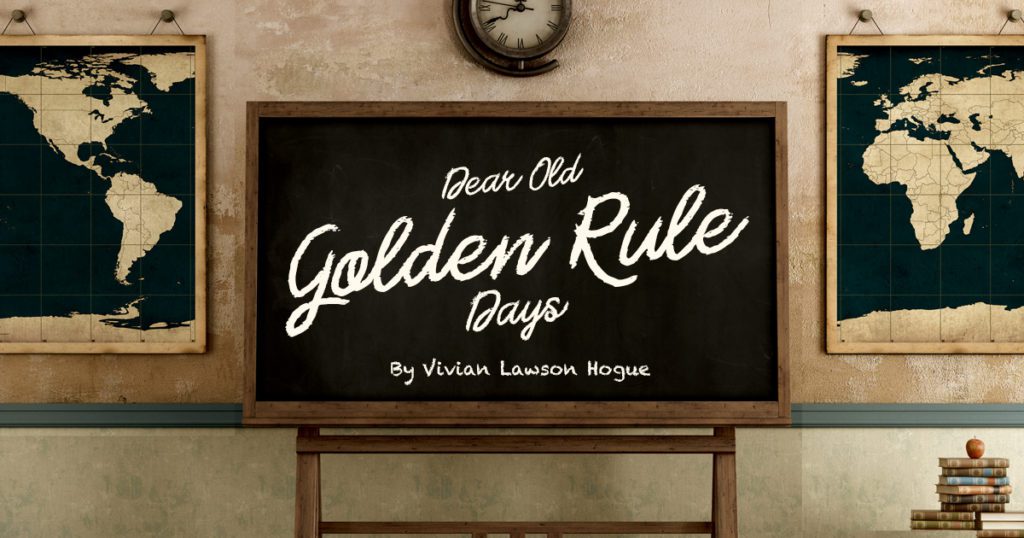07 Aug 2023 Dear old golden rule days
By Vivian Lawson Hogue
My dad’s first book was published when he was 72. It was based on his early life experiences growing up in his log cabin home. His next book, published in 1979 at age 79, was “A History of Sloan-Hendrix Academy,” which is where he graduated, later taught and met another teacher, my mother.
Of his early education, he said, “My mother taught me the alphabet from the Bible and our log cabin’s ‘wallpaper,’ which was old newspapers, and to count to 100 before I started school.” His one-room school in the small, rural community of Post Oak had a blackboard and seats of split logs. Well water was kept in a bucket and everyone drank from the same dipper. It could be said they developed herd immunity, as illnesses were few.

School hours were from 8 a.m. to 4 p.m. Restrooms were two wooden privies separated by gender. They were 300 feet from the school, presumably downwind. Dinner (“lunch” outside the South) was brought from home in a lard bucket, perhaps biscuits with apple butter or fried eggs and meat. Clothing for boys was usually well-worn overalls, homemade shirts and shoes likely worn by previous owners. With no playground equipment, children played many activity games involving running and chasing. No one was overweight.
The favorite textbooks were the McGuffey Readers. They taught reading, and the illustrated stories included the importance of moral values such as truth, loyalty, work ethics, and the social needs of politeness, justice and respect. Deskwork was done with chalk on thin, framed slabs of slate.
A creek 200 yards from the school sometimes froze hard enough for children to skate in shoes. And to verify great-grandpa’s stories, they really DID walk at least a mile to school, snow or not. In some cases, wagons or horses were available but it would be a cold trip, regardless.
When dad passed the highest grade available in his one-room school, he was accepted into Sloan-Hendrix Academy, a church-sponsored high school at Imboden. Tuition was $4 a month. Dad lived about three miles away, and he walked those three-mile round trips every day after studying subjects such as English, Latin, ancient history, algebra, grammar, composition and comprehension. There, he found his niche in learning and never lost it. Even now, my parents’ textbooks would be considered college level.
There would be little point in recounting these stories except to contrast later school conditions, students, teachers and teaching methods. Three of my older siblings were Great Depression and World War II kids but fared well even after hard times, losing their home and belongings to fire in 1934 and moving occasionally. Still, our parents insisted on education and high ethics as they were the two primary ways to succeed and become of value to oneself and others.
My youngest brother and I were pre- and mid-WWII babies and saw somewhat better post-war living circumstances. We walked four blocks to school, then ate ripe persimmons from the Hartons’ tree on the way home, or threw them at each other. No textbooks with moral emphases, but we enjoyed the “Fun with Dick and Jane” readers, the smell of new crayons, pencils, paper and mimeographed worksheets. We played pick-up sticks or congregated at the iron monkey bars and merry-go-rounds on dusty school grounds. School dinners were delicious home-cooked meals freshly prepared by the cafeteria ladies.
Upon my reaching high school in 1959, classes in Latin and Spanish were offered. English classes included required memorization of Macbeth’s soliloquy by Shakespeare. If you wanted band or choir, you could have either or both. If you wanted painting and drawing, you were on your own! And some of us did do “our own” and made a living or hobby with it. I was privileged to teach art there 29 years later, and did so for 20 years.
School assemblies included local pastors who delivered brief scriptures and prayers. Fridays were for pep rallies, with the band playing as cheerleaders twirled down the auditorium aisles in their ankle-length, corduroy skirts. There were no fights, illegal drugs or disrespect, but in 10 years that would change.
My own children, who graduated in 1987 and 1990, were not far from the 1961 curriculum, but it was changing. Social customs and behaviors were changing too, as was family life. One student said he seldom saw his parents, that they would leave notes to each other on the kitchen counter. Another student lived in a car under a bridge.
For various reasons, our country now has 3.7 million homeschooled students. Homeschooling allows one-on-one teaching from approved textbooks and methods, with school days holding flexible schedules. There are helpful networks of other supportive parents. Students might learn to cook, plant gardens and build simple projects. They can play sports or play instruments. Even so, they still have to satisfy learning levels and pass tests.
We must remember this is not new. Our ancestors from other continents arriving on our coasts in the 1600s taught their children in these same ways. Most families had few books, but many had Bibles.
Mahatma Gandhi said, “There is no school equal to a decent home, and no teacher equal to a virtuous parent.” For answers to problems in education, here is the recipe that worked before: decent homes and virtuous parents … served with a generous side of the Good Book.
- And that’s what Christmas is really all about - December 2, 2025
- Giving thanks - November 4, 2025
- Giving up was not an option - September 30, 2025








